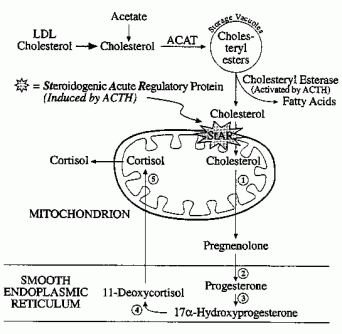TRT decreases the amount of intratesticular testosterone (ITT) needed for proper sperm production. This confusing fact may be due to the shut down of LH and FSH caused by the negative feedback loop in the hypothalamic-pituitary-testicular axis caused by TRT. ITT is needed for proper sperm production. Can HCG help increase it since it resembles LH?
As shown in several studies, HCG can increase sperm production in many men on TRT:
Best HCG Dose for Men on TRT: Two Studies That Used HCG with Testosterone
The investigators in the study below determined ITT (intratesticular testosterone- inside the testicles) concentration by testicular aspiration before and after treatment in men receiving exogenous testosterone to block endogenous gonadotropin (LH and FSH) production and randomly assigned to one of four doses of human chorionic gonadotropin (hCG) (0, 125 IU, 250 IU, 500 IU every other day) for 3 weeks.
Notice how at time zero, 17-hydroxyprogesterone and intratesticular testosterone are very low due to testosterone therapy.
This study shows that HCG increases not only intra-testicular testosterone (responsible for sperm production) but also 17-hydroxyprogesterone, androstenedione and DHEA.
Measuring blood levels of 17-hydroxyprogesterone may be a more practical way to measure ITT than performing an aspiration of testicles, a procedure that can be painful. ITT measurement can make it possible to adjust HCG dose to improve ITT so that sperm production can be restored while on TRT. Any dosage changes of HCG require at least 6 to 8 weeks wait time to measure sperm quality, so early ITT measurements can help improve the speed and accuracy of fertility enhancement of men using TRT using HCG.
NOTE: Normal ITT values for healthy men NOt on TRT ranges from 900-1200 nmol/L
Most men responded to HCG as their ITT increased with increased HCG dose. However, a few men did not respond well as seen in the white circle data points.

Is this part of the reason why men feel better on TRT + HCG?
Serum 17-hydroxyprogesterone strongly correlates with intratesticular testosterone in gonadotropin-suppressed normal men receiving various dosages of human chorionic gonadotropin

As shown in several studies, HCG can increase sperm production in many men on TRT:
Best HCG Dose for Men on TRT: Two Studies That Used HCG with Testosterone
The investigators in the study below determined ITT (intratesticular testosterone- inside the testicles) concentration by testicular aspiration before and after treatment in men receiving exogenous testosterone to block endogenous gonadotropin (LH and FSH) production and randomly assigned to one of four doses of human chorionic gonadotropin (hCG) (0, 125 IU, 250 IU, 500 IU every other day) for 3 weeks.
Notice how at time zero, 17-hydroxyprogesterone and intratesticular testosterone are very low due to testosterone therapy.
This study shows that HCG increases not only intra-testicular testosterone (responsible for sperm production) but also 17-hydroxyprogesterone, androstenedione and DHEA.
Measuring blood levels of 17-hydroxyprogesterone may be a more practical way to measure ITT than performing an aspiration of testicles, a procedure that can be painful. ITT measurement can make it possible to adjust HCG dose to improve ITT so that sperm production can be restored while on TRT. Any dosage changes of HCG require at least 6 to 8 weeks wait time to measure sperm quality, so early ITT measurements can help improve the speed and accuracy of fertility enhancement of men using TRT using HCG.
NOTE: Normal ITT values for healthy men NOt on TRT ranges from 900-1200 nmol/L
Most men responded to HCG as their ITT increased with increased HCG dose. However, a few men did not respond well as seen in the white circle data points.
Is this part of the reason why men feel better on TRT + HCG?
Serum 17-hydroxyprogesterone strongly correlates with intratesticular testosterone in gonadotropin-suppressed normal men receiving various dosages of human chorionic gonadotropin
Last edited:














